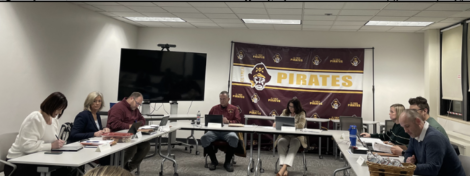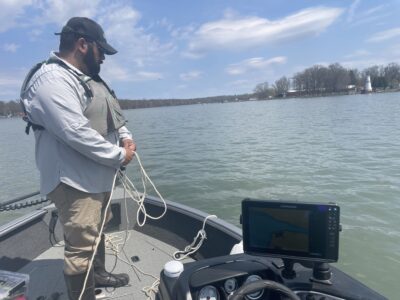‘It’s Horrible’
Weed Growth In Chautauqua Lake Southern Basin Increasing Concern

A drone photo of the southern basin of Chautauqua Lake as it stood on July 24. Photo courtesy of Chautauqua Lake Partnership
The condition of the southern basin of Chautauqua Lake has noticeably deteriorated over this past summer, and one homeowner by the lake is hoping something can be done to fix it.
Jamie Kilgore, who owns a home by the southern basin, noted that the condition of the lake has deteriorated rapidly this summer, expressing frustration in not only the condition but the apparent lack of concern about it from some groups that focus on and take care of the lake, except for the Chautauqua Lake Association, which she noted has been trying to help.
“I’m worried that this is a potential new normal for the southern basin,” Kilgore said. “The lake is always a concern to us, but this condition is at an all time high this year. It’s a literal field of weeds; we had birds literally standing on the lake.”
While the condition of Chautauqua Lake’s southern basin is something Kilgore said they always watch, it is also something that has been exacerbated this summer. Additionally, she said she feels her concerns about the increasing amount of weeds is being largely ignored by other lake organizations besides the CLA.
“It seems the Chautauqua Lake Association is putting their best foot forward and working on helping, but they need help,” Kilgore said. “There has been years worth of research done on the lake. The Chautauqua Lake and Watershed Management Alliance needs to work together with the data that we already have in a way that is productive to help the lake.”
Kilgore said that the reason they purchased a home by the lake is that it can be amazing and relaxing, but described this summer as stressful while watching the southern basin’s condition deteriorate. She added they are by the lake all summer besides one week, and when they returned from that week away the lake was already in its deteriorating condition.
“It’s stressful to watch this decline as a homeowner,” Kilgore said. “It can’t continue as it is. It’s horrible. And this is not to diminish the work being done by the CLA, who are doing their best, but it’s not enough.”
‘FINALLY SEEING A DENT’
Heather Nolan-Caskey with the CLA said most of the problems with the southern basin that they have been hearing is focused on the amount of weed growth in the area, adding that they have been actively working in that area to help get rid of the weeds.
While she said some homeowners may feel that they are not doing enough because after they come and work in front of their house the weeds have sometimes come back, they have increased the amount of harvesters out there from two to five. Additionally, she said a lot of what is being done that is finally allowing for a visible change is teamwork between multiple entities.
“The community is coming together to help and we are finally seeing a dent,” Nolan-Caskey said. “People have suggested using herbicides, but the bulk of the weeds are a native species and there is currently no approved herbicide in New York State for a native species.”
Work reports on what all the CLA has been doing to help the southern basin can be found on their website, chautauqualakeassociation.org. Nolan-Caskey said the biggest thing that is going to help and has been helping eradicate the weeds is people working together.
“We see community members, residents and our employees working together, and that’s how we will finally tackle this,” Nolan-Caskey said. “It’s positive to see that finally happening.”
AMENDED APPLICATIONS FOR TREATMENT
In a statement to the Post-Journal, the Chautauqua Lake Partnership, which has also been working to help the Southern Basin said that based on the 2024 NCSU aquatic plant survey, and after a lengthy and complex process which included wetlands Article 24 permitting in addition to Article 15 Herbicide permitting, the CLP facilitated treatment of 286 Acres for curly leaf pondweed on April 28 and 29 and 172 acres for milfoil on June 5. The DEC initially approved 463 acres for curly leaf pondweed, but curtailed the area on the day of treatment due to lack of plant presence at that time.
“As we observed plant growth taking off in May, we amended applications to add additional treatment areas for milfoil, but due to DEC procedural inefficiencies related to wetlands regulation these were not approved in a timely fashion,” the statement continues. “As a result, only very small targeted areas will receive any additional treatment in 2025. This year in addition to invasive species, we are experiencing an abnormal explosion of native plant growth mainly in the south end of the lake and to a lesser extent throughout the entire lake. The plant now causing problems in the south basin is elodea – a native plant also known as western waterweed.”
LOOKING AHEAD
Looking ahead to 2026, the CLP said it is clear a new approach is needed, starting with stronger collaboration between lake groups. Positive steps are already underway, with better communication and cooperation between the CLA and CLP following recent CLA leadership changes, they added.
“The CLA is working more efficiently now than ever, and we are confident they are doing the best they can to deal with the challenging conditions in the south basin,” the CLP said. “We will also continue advocating for a centralized lake manager to continue to drive this new cooperation forward. As for specific future actions, while herbicides may be considered for native plants in addition to invasives in key navigation areas and commercial shorelines, our consultants advise against widespread use on native plants to avoid expansion of invasive species or algae dominance. The ultimate solution: reduce nutrient levels.”
Findings from both the Jefferson Project and DEC’s internal loading study are expected to confirm internal nutrient loading as the main driver of excessive plant growth and HABs. The USAC restoration project — done by the Army Corp of Engineers and the ongoing Aquatic Restoration Project — will offer recommendations in 2026, likely including dredging or nutrient inactivation. The CLP will be pushing to fast-track real action instead of more future studies. Concerned stakeholders can help by contacting the DEC (716) 851-7200 to voice support for action to the Region Nine Director, Julie Barrett-O’Neill. More detailed information on herbicides used, maps of treatment areas, and more can be found on the CLP website at chqlake.org.




